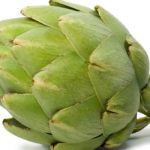 Eating Your Landscape
Eating Your Landscape
The idea of creating an edible landscape is very appealing. How wonderful it would be to have a snack at hand, anywhere in your yard? It sounds like the perfect solution for gardeners with limited space and many vegetables are as attractive as so called ornamental plants. And they can’t be much more labor intensive than caring for a lawn.
- Artichokes
- Greenbeans
- Eggplants
- Onions / Chives
- Garlic
- Peppers
- Herbs
- Edible Flowers
- Fruit Trees
- Berries
Artichokes
Artichokes and cardoons are imposing plants that would be worth growing in the landscape, even if you couldn’t eat them. I haven’t had any problems with animals munching on the prickly leaves and as long as the flowers are a few feet off the ground, nothing has touched them. The only time I lost a bud to animal grazing was when I had a small plant growing in a container. Had I raised the container a bit, I don’t think that would have happened.
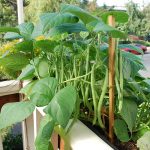 Beans / Greenbeans
Beans / Greenbeans
The leaves of bean plants are more attractive to animals than the bean pods. I grow pole varieties in my borders and I encircle the bottoms of the plants in chicken wire. It isn’t particularly noticeable at a distance and the plants eventually cover it. I may lose some leaves that poke through, but the animals don’t destroy the whole plant and the beans remain intact, for me to harvest.
Trellising pole beans on any decorative structure or even a simple bamboo teepee is an easy way to add height to your flower border. They grow faster than most annual flowering vines and bean flowers are just as lovely. If you want more ornamental pow, you can grow a colorful variety, like Long Red Noodle beans or Dragon Tongue.
Eggplants
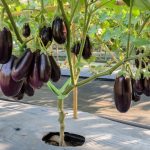 No four-footed animal has ever touched my eggplants. Maybe that’s because they are scratchy and thorny or maybe there are better things to eat in the yard, but I’m happy either way. Flea beetles can make eggplant leaves unsightly in a matter of days, but they seem to do less damage when the eggplants are interspersed among scented flowers, so I consider planting them in the flower border a win-win.
No four-footed animal has ever touched my eggplants. Maybe that’s because they are scratchy and thorny or maybe there are better things to eat in the yard, but I’m happy either way. Flea beetles can make eggplant leaves unsightly in a matter of days, but they seem to do less damage when the eggplants are interspersed among scented flowers, so I consider planting them in the flower border a win-win.
Onions
Onions are edible bulbs. They are members of the allium family, along with chives, garlic, leeks, shallots and ornamental alliums. Onion bulbs are round or oblong and are composed of concentric layers. They can have either a pungent smell and taste or be quite sweet, depending on the variety.
 Peppers
Peppers
I have the same problem with peppers as I do with beans; the leaves are more attractive to animals than the fruits. Young transplants seem to be especially vulnerable. Once the stems toughen up, the damage becomes minimal. Knowing that, I wait until they are about 6 inches tall, before I plant them in the open.
I’m sure you don’t need any convincing to think of peppers as ornamental plants. In fact, many hot peppers are sold as ornamentals. There are certainly more than enough hot pepper varieties to fill a yard, but don’t overlook the sweet types. 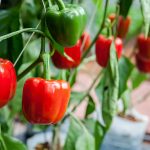 Since peppers tend to take awhile to reach their full color, you will have a rainbow of chartreuse, red, orange and purple throughout the season.
Since peppers tend to take awhile to reach their full color, you will have a rainbow of chartreuse, red, orange and purple throughout the season.
Herbs
The perennial herbs are the safest choice for edible landscaping. Annual and biennial herbs, like parsley, basil and cilantro, are surprisingly appealing to animals, considering their strong scent. Maybe it’s their succulent foliage that makes them targets. But woodier herbs, like sage, oregano, thyme, rosemary and lavender, have all fared better in my yard. Mint has also remained attack-free, although I can’t say I would mind 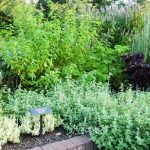 if someone wanted to thin out my patch for me.
if someone wanted to thin out my patch for me.
Flowers
Eating flowers from the flower garden can seem unnatural. Somehow planting them in the vegetable garden makes it seem more allowable to snip them for a salad. But growing edible flowers throughout your yard should be a no brainer in creating an edible landscape and I hope you’ve already realized this. Just be sure not to feed or spray them with anything you shouldn’t be ingesting.
Fruit Trees
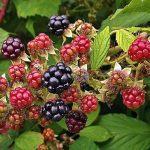 Although fruits and nuts are certainly alluring to animals, there is generally enough to go around, with a little netting and protection. The real advantage of using these plants as edible landscape is that they require minimal care and most look good for at least 3 seasons. A little spring pruning and feeding and most will take care of themselves. And I’d challenge anyone to find a shrub with more visual impact than a blueberry that covers itself with white flowers in spring, dusky purple berries in summer and radiant red leaves in the fall.
Although fruits and nuts are certainly alluring to animals, there is generally enough to go around, with a little netting and protection. The real advantage of using these plants as edible landscape is that they require minimal care and most look good for at least 3 seasons. A little spring pruning and feeding and most will take care of themselves. And I’d challenge anyone to find a shrub with more visual impact than a blueberry that covers itself with white flowers in spring, dusky purple berries in summer and radiant red leaves in the fall.
Gardens and Landscapes will always prove to be a challenging endeavor, however take comfort in knowing Ryno Lawn Care is here to help. Call now for a free quote.
